The process differences between solid-state batteries and traditional liquid batteries
I. Differences in Manufacturing Processes between Solid-State Batteries and Traditional Liquid Batteries
Solid-state batteries use solid electrolytes to replace the electrolyte and separator in traditional liquid batteries. Traditional lithium-ion batteries are composed of four key elements: the positive electrode, the negative electrode, the electrolyte, and the separator. Solid-state batteries use solid electrolytes to replace the electrolyte and separator in traditional liquid batteries.
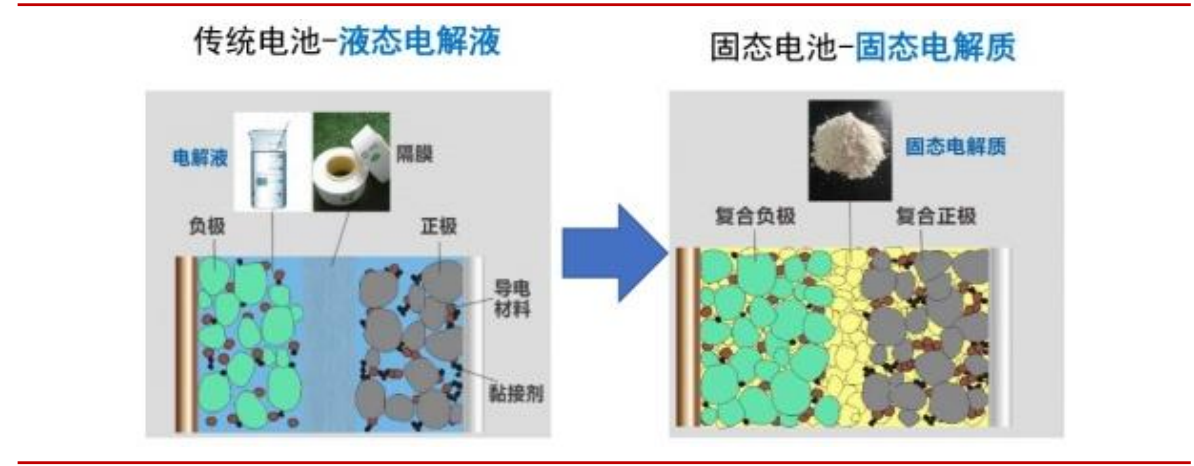
Due to the adoption of a completely new material system and battery structure, the existing traditional lithium battery manufacturing processes and equipment cannot be used for the industrial production and manufacturing of all-solid-state batteries. Corresponding innovations and improvements are required. Currently, all-solid-state batteries have not yet been mass-produced, so the production process has not been standardized. Moreover, the production processes and manufacturing procedures of different types of solid-state batteries will vary, depending on the battery design and application. However, it is certain that the production process of all-solid-state batteries differs significantly from that of existing traditional liquid batteries. The main differences are as follows:
1.The front-end electrode sheet manufacturing process
Conventional lithium-ion batteries: Wet slurry mixing and coating techniques are used to blend active materials, conductive agents, and binders into a slurry, which is then coated onto the current collector. Subsequently, the process involves drying and calendering.
Solid-state batteries: The dry electrode technology is introduced, eliminating the use of solvents. The electrode sheets are directly prepared through dry slurry mixing and coating processes. Additionally, an electrolyte membrane coating and rolling process are required to form the solid-state electrolyte layer.
2. Mid-section battery cell assembly stage
Conventional lithium batteries: The positive and negative electrode sheets and separator are wound or stacked to form cells, which are then filled with electrolyte and packaged.
Solid-state batteries: Utilizing a laminating process, combined with electrode sheet adhesive frame printing and isostatic pressing technology, ensure a tight contact between the solid electrolyte and the electrodes. As all-solid-state batteries do not require electrolyte, the liquid injection process is eliminated.
3. Post-forming and packaging stage
Traditional lithium batteries: After packaging, the battery is activated through low-voltage formation.
Solid-state batteries: Due to the high ion conductivity requirement of solid-state electrolytes, the formation process tends to be high-voltage to optimize battery performance.
Overall, the core production processes of all-solid-state batteries and traditional liquid lithium batteries mainly differ in the following aspects: In the front-end solid electrolyte and electrode sheet manufacturing stage, all-solid-state batteries are more suitable for dry electrode technology, adding dry mixing and dry coating to prepare solid electrolyte films; in the middle stage of cell assembly, solid-state batteries use "laminating + electrode sheet adhesive frame printing + isostatic pressing technology" to replace the traditional winding process and eliminate the liquid injection process; in the back-end formation and packaging stage, the process shifts from formation and capacity sorting to high-voltage formation and capacity sorting.
II. Solid-State Battery Manufacturing Process
1.Dry electrode technology is more suitable for solid-state batteries.
The greatest advantage of dry electrode technology lies in its ability to increase the compaction density of electrodes, thereby enhancing the energy density of batteries. Dry electrode manufacturing is a novel electrode production process, with the key advantage of being able to increase the compaction density of electrodes. Currently, lithium batteries mainly employ the traditional wet electrode manufacturing process. In the wet electrode manufacturing process, solvents are used to mix active materials, conductive agents, and binders, which are then coated onto the current collector, followed by drying, NMP solvent recovery, and rolling. In contrast, dry electrode technology directly mixes electrode materials into dry powder and mechanically presses them onto the current collector to form electrode sheets. This method can increase the compaction density of electrodes. For solid-state batteries, a higher compaction density means that more positive and negative electrode materials can be accommodated in the same volume, thereby increasing the energy density of the battery.
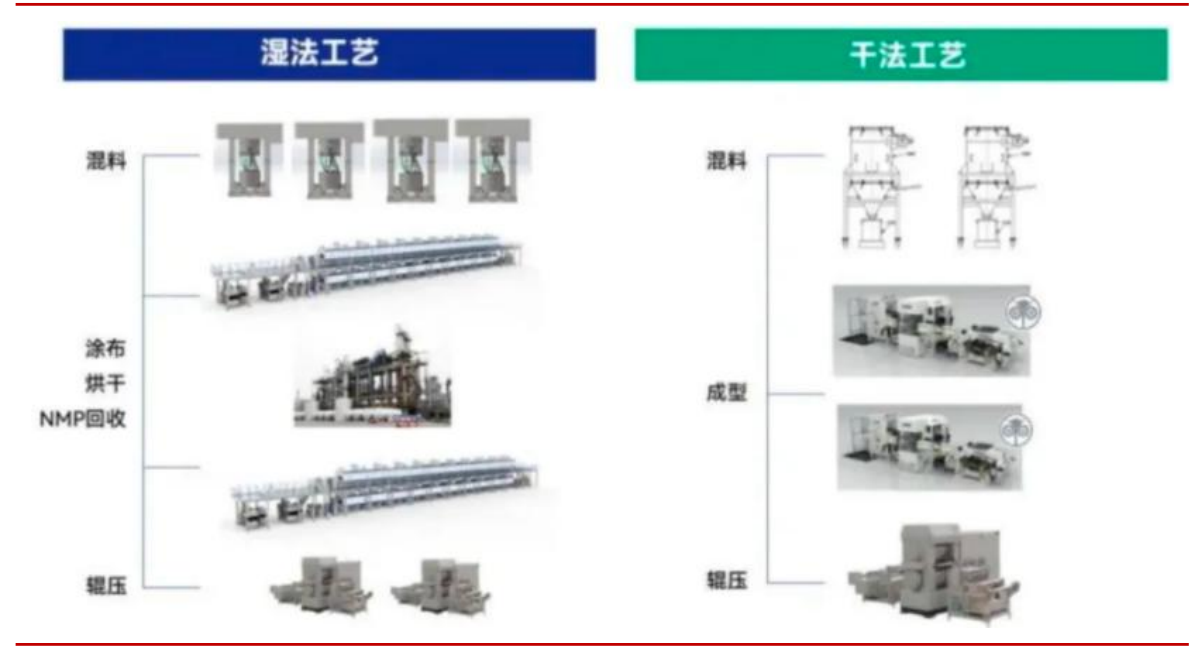
Dry electrode technology is more suitable for high energy density batteries such as solid-state batteries. The concept of dry electrode technology is similar to that of solid-state batteries. In all-solid-state batteries, sulfide electrolytes are sensitive to organic solvents, and metallic lithium is prone to react with solvents, causing expansion. The traditional PVDF-NMP system has limited bonding strength. However, in dry electrodes, the two-dimensional network structure formed by the fibrillation of PTFE (polytetrafluoroethylene) can suppress the volume expansion of active material particles and prevent them from detaching from the current collector surface.
In addition, by adopting the dry electrode process, the electrode sheet manufacturing process of solid-state batteries can be completely dry, eliminating the problem of residual solvent molecules after drying in the wet process. Therefore, the dry electrode technology is more suitable for the production of solid-state batteries.
The dry electrode technology simplifies the process and boosts efficiency, offering cost advantages and facilitating the commercialization of solid-state batteries. The dry electrode process can simplify the production process, reduce costs, and enhance production efficiency. The manufacturing of dry electrode sheets does not require NMP solvents, eliminating the need for drying and solvent recovery steps in the electrode sheet production stage. It integrates the electrode manufacturing process, combining the mixing, slurry-making, coating, drying, and rolling processes required in the wet process into one, making the process flow simpler and reducing the equipment footprint. According to NacoNol's estimation, the mass production of dry electrodes can reduce battery costs by more than 10%. Moreover, the simplified process of dry electrode technology is suitable for large-scale production of battery electrode sheets. Therefore, dry electrode technology is regarded as one of the key technologies to promote the commercialization of solid-state batteries.
According to NacoNol, the key challenges of the current dry electrode technology lie in the uniformity of the mixed electrode material powder and the consistency of the film formation. In terms of equipment, the dry process has higher requirements for the precision, uniformity and compaction density of the roller pressing.
2. Mid-section battery cell assembly stage: "Lamination + electrode sheet frame printing + isostatic pressing technology" are adopted.
① Stacker: Solid-state batteries are not suitable for winding equipment and require stackers instead, with higher precision requirements.
Both solid-state batteries and liquid-state batteries require laminating machines. However, due to the brittle nature of the solid electrolyte in solid-state batteries and the higher precision and stability requirements for equipment, more laminating processes are needed for solid-state batteries. Therefore, the demand for laminating machines in the manufacturing of solid-state batteries will also increase.
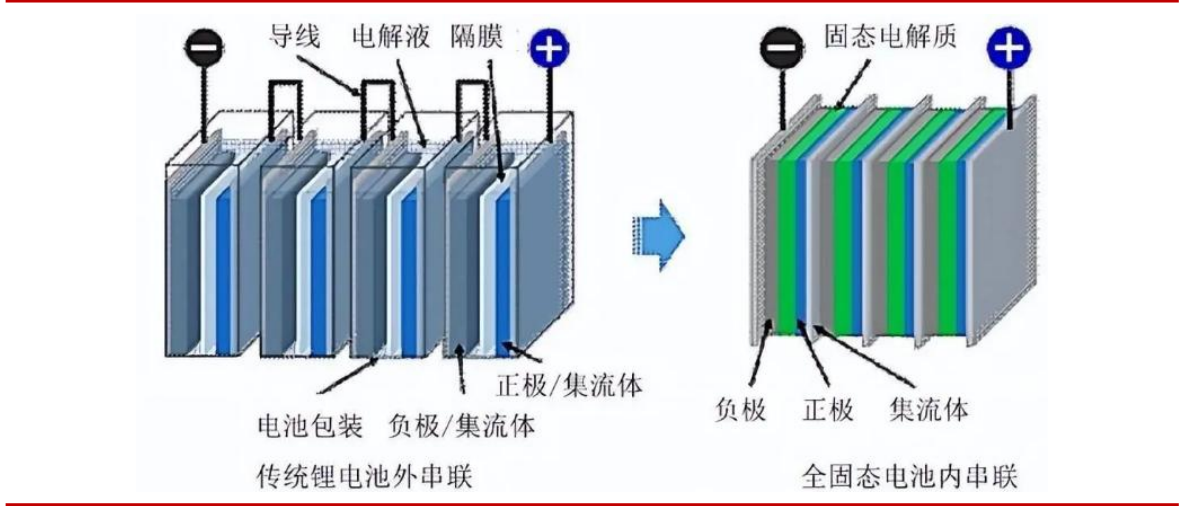
②Solid-state battery electrode sheet adhesive frame lamination technology: Improves the adhesion of solid-state battery electrode sheets and avoids internal short circuit problems.
The current production process of solid-state batteries is still not mature and has some shortcomings. When the electrode sheet material rolls are cut and then combined with other electrode sheets to prepare solid-state battery cells, it is difficult to ensure a high degree of adhesion between adjacent electrode sheets, which leads to a decline in the quality of solid-state battery cells. According to the patent technology disclosed by Liyuanheng, it proposes a method, device and stacking equipment for covering the solid-state battery electrode sheet with a frame, which can improve the adhesion between adjacent electrode sheets in the solid-state battery cell and ensure the excellent quality of the solid-state battery cell.
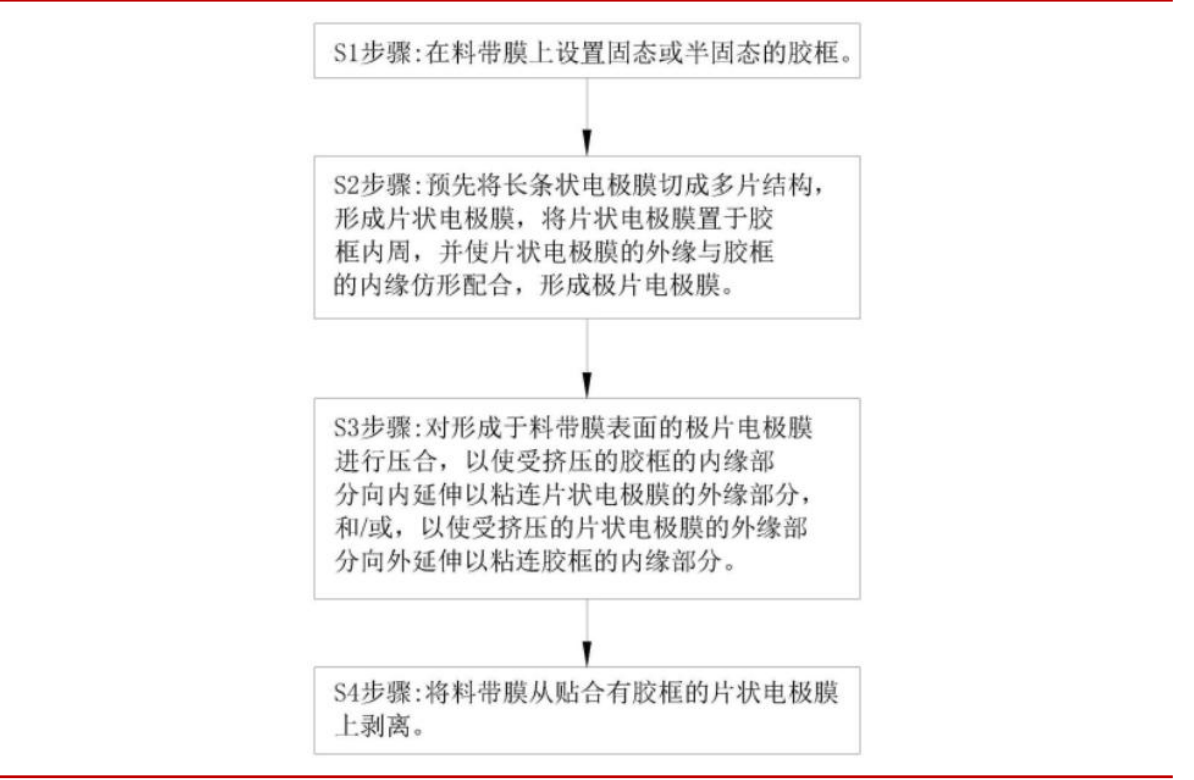
③ The isostatic press is one of the core incremental equipment: Isostatic pressing technology is used to improve the solid-solid interface contact problem of solid-state batteries.
The production of solid-state batteries typically involves stacking the cathode, solid-state electrolyte, and anode together for assembly. Considering that the solid-state electrolyte needs to form a good solid-solid interface contact with the electrodes, contact loss may occur during cycling, and lithium dendrite formation needs to be suppressed, additional pressurizing equipment is required during stacking to apply a pressure exceeding 100 MPa to ensure the materials are densely packed. Traditional hot pressing and roller pressing methods provide limited pressure and uneven application of pressure, making it difficult to guarantee the consistency of dense packing, which in turn affects the performance of solid-state batteries.
Isostatic pressing technology is based on Pascal's principle. Materials such as metals, ceramics, composites, and polymers can all be densified and voids eliminated. For solid-state batteries, isostatic pressing technology can effectively eliminate voids within the battery cells, ensuring that the electrolyte material achieves the desired level of densification, enhancing the contact between components within the cell, thereby significantly increasing the ionic conductivity by over 30%, reducing the internal resistance of the battery by more than 20%, and increasing the cycle life by 40%, greatly improving battery performance. The equipment required for isostatic pressing is an isostatic press.
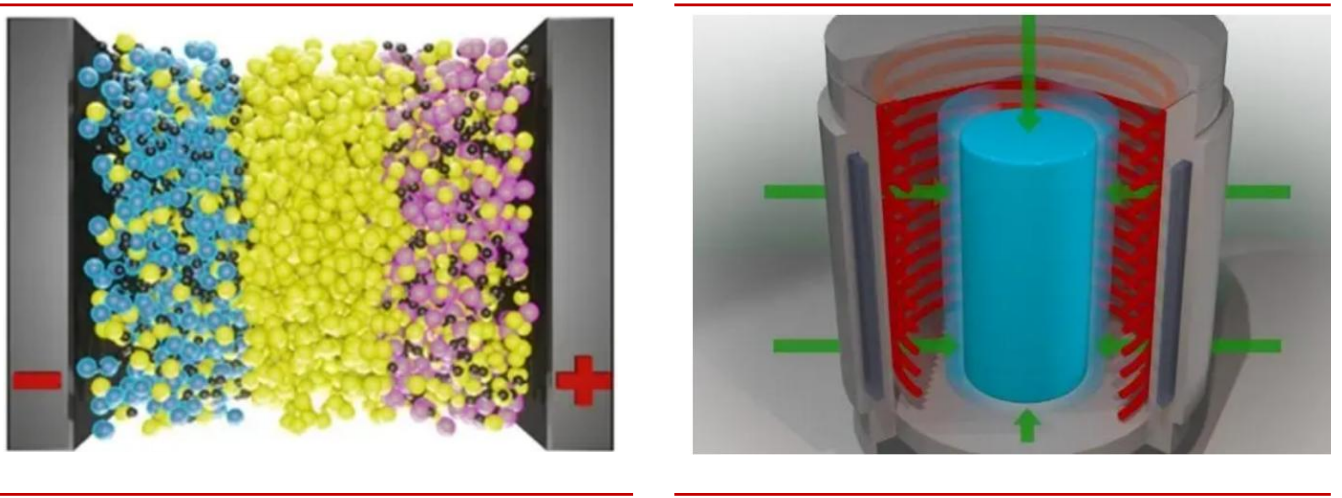
The current challenges faced by isostatic pressing technology in the field of solid-state battery manufacturing: Isostatic pressing technology itself is a mature technology that has been widely applied in fields such as ceramics and powder metallurgy. However, its application in the solid-state battery field is still in the exploration and development stage, with relatively low technological maturity. Currently, the promotion of isostatic pressing technology in the solid-state battery field still faces challenges such as how to select the appropriate combination of pressing temperature and pressure, how to control the pressing quality, and how to improve production efficiency and yield.
3. Post-segment formation and packaging stage: New high-voltage formation equipment is added.
The conventional pressure requirement for lithium battery formation is 3 to 10 tons, while for solid-state batteries, it increases to 60 to 80 tons. The core reason why solid-state batteries need high-pressure formation lies in their unique solid-solid interface characteristics and ion conduction mechanism, which are fundamentally different from the formation process of traditional liquid batteries.
① Solving the solid-solid interface contact problem: The contact between solid electrolyte and electrode is rigid, with microscopic voids and poor contact. It is necessary to eliminate the interface voids and increase the effective contact area by high pressure (usually 60-100 MPa) pressing; promoting the physical/chemical bonding between solid electrolyte and electrode.
②Activate ionic conduction channels: The ionic conductivity of solid electrolytes is low, and high-voltage formation is required to force lithium ions to penetrate the solid-solid interface barrier, form an ionic conduction network at the interface, and reduce the interface impedance.
[Disclaimer] This article is sourced from the "New Energy Era" WeChat official account.

